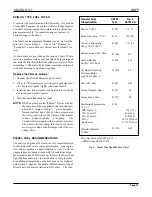
DDFP
DESCRIPTION
SECTION 1
Page 2
Introduction
NFPA Pamphlet 20 sta tes "The compression ignition diesel
engine has proved to be the most de pendable of the inter nal
combustion engines for dri ving fire pumps." The diesel en -
gine will operate under emer gency power conditions w here
loss of utility or stand-b y electric po wer renders electric
motor driven pumps useless. The diesel driven fire pump sys-
tem is preferred by most insurance companies.
This manual co vers Detroit Diesel engines. These engines
have been manuf actured with specif ic options to function
integrally with an automa tic engine controller for stand-by
fire protection service and to meet NFP A-20 requirements.
These systems ar e designed to function under emergenc y
conditions and to assist in holding fire damage to a minimum.
Complete understanding of the operation and maintenance of
this fire protection system is essential to ac hieve this objec -
tive.
A separate manual co vers the operation and maintenance of
the Automatic Engine Controller (AEC).
The two-cycle engines co vered in this man ual are produced
with v arious c ylinder arrangements. The same bore and
stroke and many of the major working parts such as injectors,
pistons, connecting rods, cylinder liners and other par ts are
interchangeable within eac h engine series. The engines are
either naturally aspirated (NA) or turbocharged (T) and some
units are turbocharged and aftercooled (TA).
The engines ha ve either an in-line or a vee type c
ylinder
arrangements. The engine may ha ve clockwise (CW) or
counter-clockwise (CCW) r otation. Rotational reference is
made from a front vie w of the engine to deter mine the rota-
tion of the output shaft. All other engine references, (
right
or
left
side) are made from a rear view of the engine, looking at
the flywheel.
All DDFP engines are Underwriters Laboratories (UL) listed,
Underwriters Laboratories of Canada (ULC) listed and/or
Factory Mutual (FM) approved and meet the requirements of
the National Fire Protection Association (NFPA) standard 20.
Each engine is equipped with an oil cooler, lubricating oil fil-
ter, fuel f ilters, air cleaner, heat e xchanger, starting motor,
alternator, instrument panel and engine jacket water heater.
Full lubrication oil pressure is supplied to all main, connect-
ing rod and camshaft bear ings, and to other mo ving parts
within the eng ine. A gear type pump dr aws oil fr om the oil
pan through an intak e screen, through the oil f ilter and then
to the oil cooler. From the oil cooler the oil enter s a longitu-
dinal oil g allery in the c ylinder b lock where the suppl y
divides and is channeled to the turbocharger (if included), to
the cam and balance shaft end bear ings and c ylinder head,
with the remainder going to the main bear ings and connect-
ing rod bearings via the drilled crankshaft. The oil then drains
back into the oil pan.
Coolant is circulated through the engine by a centrifugal-type
water pump. Heat is removed from the coolant as it circulates
in a closed system through the heat exchanger. Control of the
engine temperature is accomplished b y a thermostat which
regulates the f low of the coolant within the cooling system.
Raw water from the fire pump passes thr ough a tube bundle
in the heat e xchanger to remo ve the heat from the engine
coolant.
Fuel is dra wn from the suppl y tank through a str ainer by a
gear-type fuel pump. It is then forced through a filter and into
the fuel inlet gallery in the cylinder head and to the injectors.
Excess fuel is r eturned to the suppl y tank through the fuel
outlet g allery and connecting lines. Since the fuel is con
-
stantly circulating through the injector s, it serves to cool the
injectors and purges the system of air.
Air for sca venging and comb ustion is supplied b y a blo wer
which pumps air into the engine cylinders via the air box and
cylinder liner por ts. All air enter ing the blo wer first passes
through an air c leaner. Turbocharges, when included, are
located between the air cleaner and the blower. Some engines
also include an after cooler which cools the air prior to enter-
ing the cylinders.
Engine starting is usually provided by an electric starting sys-
tem. The electric starting motor is energized by a storage bat-
tery. A battery-char ging alter nator, with a b uilt-in v oltage
regulator, serves to keep the battery charged while the unit is
running. At rest, a battery charger in the AEC keeps batteries
charged.
Engine speed is r egulated by a mechanical type eng ine gov-
ernor with a tamper proof speed control device.
Model Numbering & Identification
Two model numbers are sho wn on this pr oduct. First is the
Clarke FM/UL/ULC a pproved model n umber sho wing the
prefix
DDFP.
Figure 3 explains the identification system on
DDFP
units. Second is the DDC basic engine model number
using eight digits. Figure 4 provides details for understanding
the significance of each digit.




















